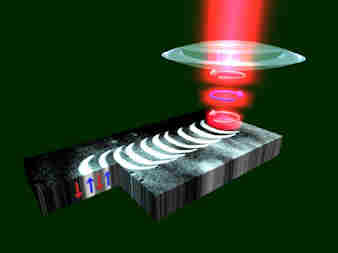Allgemeines Physikalisches Kolloquium im Sommersemester 2009
Ort: 48149 Münster, Wilhelm-Klemm-Str. 10, IG I, HS 2,
Zeit: Donnerstag, 23.7.2009 16:00 Uhr c.t.
Kolloquiums-Kaffee ab 15:45 Uhr vor dem Hörsaal
Controlling Magnetism with Light
Prof. Dr. T. Rasing, Institute for Molecules and Materials, Radboud University Nijmegen, Niederlande
The interaction of light with magnetic matter is well known: magneto optical Faraday or Kerr effects are frequently used to probe the magnetic state of materials or manipulate the polarisation of light.
The inverse effects are less known but certainly as fascinating: with light one can manipulate magnetic matter, for example orient their spins. Using femtosecond laser pulses we have recently demonstrated that one can generate ultrashort and very strong (~Tesla’s) magnetic field pulses via the so called Inverse Faraday Effect. Such optically induced magnetic field pulses provide unprecedented means for the generation, manipulation and coherent control of magnetic order on very short time scales, including the complete reversal of a magnet with a single 40 femtosecond laser pulse. In principle this opens the way for all-optical recording of magnetic bits at extremely high data rates. The basic ideas, including their limitations, behind these discoveries will be discussed and illustrated with recent results.
A.V.Kimel, A.Kirilyuk, P.A.Usachev, R.V.Pisarev, A.M.Balbashov and Th.Rasing,Ultrafast nonthermal control of magnetization by instantaneous photomagnetic pulses, Nature 435 (2005), 655-657
C.D.Stanciu, F.Hansteen, A.V.Kimel, A.Kirilyuk, A.Tsukamoto, A.Itoh and Th.Rasing, All-optical Magnetic Recording with Circularly polarized Light, Phys.Rev.Lett.99, 047601 (2007)

Demonstration of compact all-optical recording of magnetic bits by femtosecond laser pulses. This was achieved by scanning a circularly polarized laser beam across the sample and simultaneously modulating the polarization of the beam between left and right circular. White and black areas correspond to ‘up’ and ‘down’ magnetic domains, respectively.
Einladender: Prof. Dr. H. Zacharias
Im Auftrag der Hochschullehrer des Fachbereichs Physik
Prof. Dr. H. Zacharias
